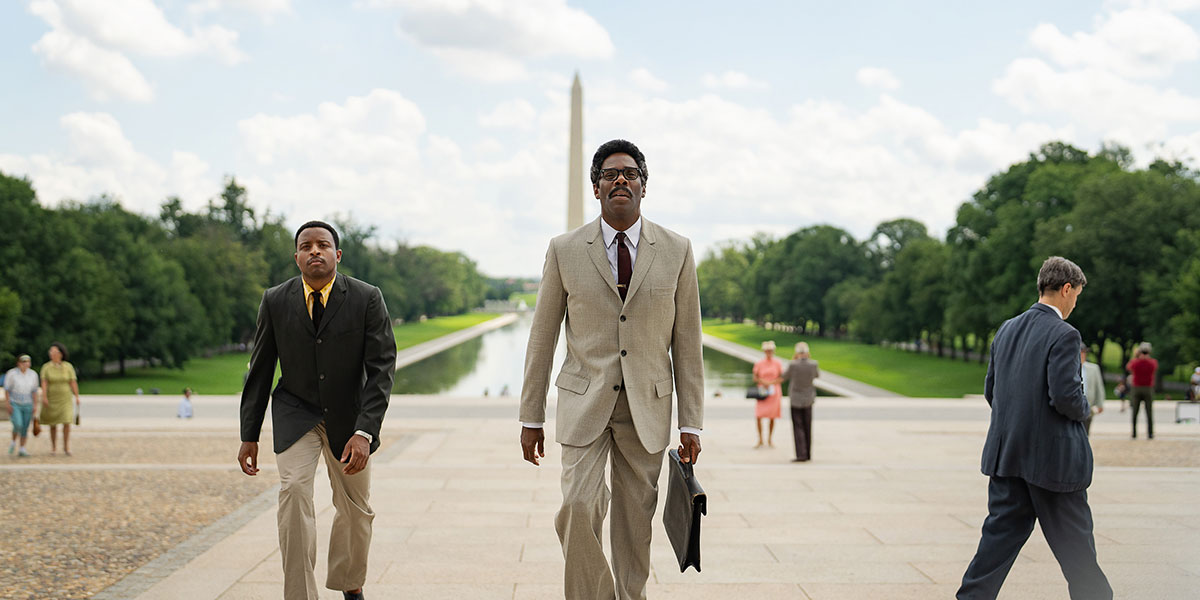Colman Domingo was the center of attention at this year’s festivities. His performances in “If Beale Street Could Talk,” “Candyman,” “Zola,” “Euphoria,” “Ma Rainey's Black Bottom”—along with his illustrious stage career—garnered him the TIFF Tribute Award for performance. And the actor had two new films screened. One he hopes will finally be his Oscar nomination, while the other is still searching for distribution.
In the role of Bayard Rustin, the towering, gay Civil Rights leader, Colman Domingo is stuck in an Oscar vehicle without windshields, doors, or a steering wheel. Director George C. Wolfe’s biopic “Rustin” opens in 1960, when Rustin befriended Martin Luther King Jr., convincing the reverend he should remain at the forefront of the movement. But the film primarily takes place in 1963 when Rustin is an outcast due to his sexuality and communist leanings from the coalition he once steered. He toils away, working for a pro-disarmament organization. And yet with the rise of younger Black leaders—CORE, SNCC, and the kindle of the Black Panthers—Rustin is already a relic of the past, along with the NAACP and MLK and his nonviolent approach.
Written by Julian Breece and Dustin Lance Black, Wolfe’s film jams two stories together: It’s about Rustin’s return to prominence as he nurtures the March on Washington, and it’s also about his internal battle to live as a gay Black man with his lover Elias Taylor (Johnny Ramey) without fear of repercussion. The two arcs barely cohere, creating a somewhat intentional tension of two lives that are not narratively complete. Many of the actors in this deep ensemble are either miscast (Chris Rock as NAACP leader and Rustin adversary Roy Wilkins) or are over-calibrated (Aml Ameen as a dry MLK). Jeffrey Wright, who feels unstoppable at this point in his career, is a vicious highlight as the homophobic Rep. Adam Clayton Powell.
Like Ava DuVernay’s “Selma,” this period piece wants to show the power of collective action. It wasn’t just Rustin that made the March happen, but a team of tireless, young volunteers. Seeing their persistent clockwork is the film’s strongest component. It’s stronger than the cinematic March itself, which flashes by, and stronger than Ameen’s lackluster rendition of the “I Have a Dream” speech.
Though “Rustin” doesn’t shy from showing the homophobic and sexist power structure of the civil rights movement, it struggles to capture Rustin’s queer existence. Wolfe and cinematographer Tobias A. Schliessler do not capture eros—the lens lacks a deep compositional interest in the body’s demands, movements, and politics as a sexually charged site for further character depth.
Other issues—such as bad green screens used for the Lincoln Memorial—undermine Domingo’s actorly choices. He’s at his best in the quieter, saucy scenes, where his wit and charm are an anchor. But he’s asked to do too much heavy lifting in the big speeches (and there are many big speeches and a lot of telling, not showing). Domingo ultimately clings to these emotional crescendos, gripping for dear life to a film that rarely, if ever, rises to his level.

Within the first shot of “Sing Sing,” featuring Colman Domingo as Divine G delivering a monologue from A Midsummer Night’s Dream, you know writer/director Greg Kwedar has got it handled. “Sing Sing” can best be described as Domingo’s “Birdman of Alcatraz” and is based on real participants of the RTA Rehabilitation Through The Arts program. Kwedar’s film tells of the damage the justice system inflicts on the psyche and a man’s desire to rise above it.
Similar to Burt Lancaster’s “Birdman,” Colman’s Divine G is a soft-spoken, meditative intellectual. Every six months, Divine G’s theater group—a team of incarcerated men at Sing Sing Correctional Facility, led by director Brent (Paul Raci)—chooses a new play to perform and new members to bring in. This time, they’ve chosen Divine Eye (Clarence Maclin), the prison’s drug dealer, to participate.
Maclin is among a cast composed, almost entirely, of real participants and alumni of RTA playing themselves. In his debut screen performance, Maclin is everything you want an actor to be: deeply felt, magnetic, emotionally and physically attuned. His star-making performance brandishes a soft touch for deep impact.
Casting is one of the many ways Kwedar opts for textured neorealism. The other is choosing to shoot on gritty 16mm, which adds tangibility to the prison surroundings (shot on location at Downstate Correctional Facility). It also works well with these performers. You can tell Kwedar and cinematographer Pat Scola (“We Grown Now”) love an actor’s face. They’re not afraid of a close-up or lingering on faces; they trust the battles and desires that can play across someone’s visage.
Much consumes Divine G: Divine Eye is challenging his place as the group’s preeminent actor; his clemency hearing is nearing; another tragedy strikes. The once mild-mannered, reflective man begins to crumble. Domingo is always a revelation, but with this character, he feels every space between words. It’s a necessity, not just because he’s the lead. But Kwedar takes care not to show trauma. The theater group’s practice room is safe, away from the dehumanizing guards and cells. Instead, the trauma that occurs is mostly psychological and internal. Every actor pulls their demons out for startling, effective scenes.
“Sing Sing” doesn’t want to solely see these men suffering; it wants to capture them spiritually free and physically unencumbered. The film’s best moments involve the men gripped by the excitement, escapism, and healing capacity of performance. It renders them as humans living through their art while composer Bryce Dessner’s quietly lyrical score wraps around their organically charged movements, boundless joy, and mutual love. Though the film has one false ending too many, “Sing Sing” is a redemptive portrait of theater’s power to heal, emancipate, and rebel.












